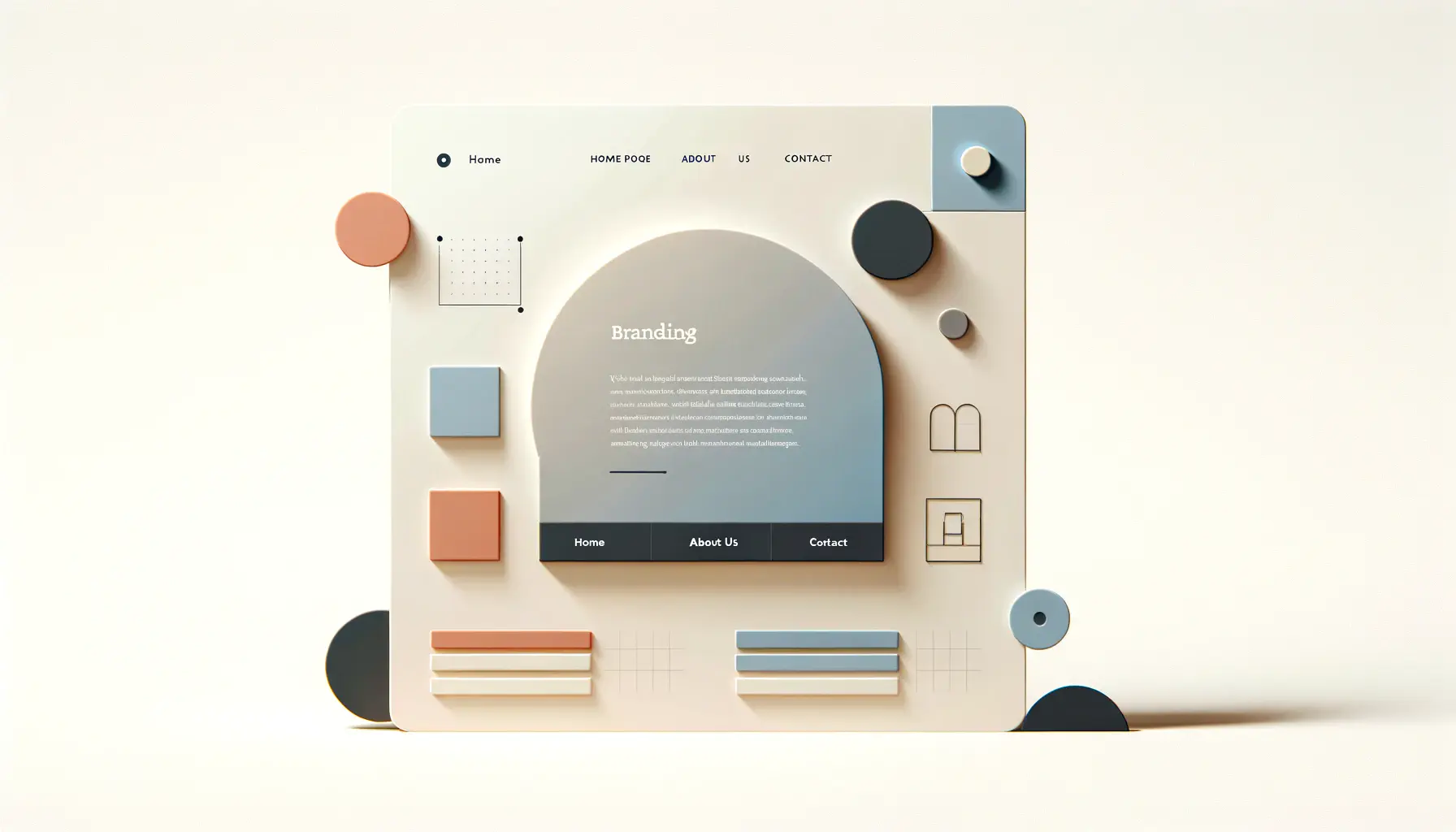The digital landscape is continuously evolving, with brands and designers constantly seeking innovative ways to engage audiences and stand out in a crowded market.
Interactive elements in branding and web design have emerged as a powerful tool to captivate users, offering them an immersive experience that goes beyond passive browsing.
This article delves into the significance of interactive elements, exploring how they are reshaping the future of branding and web design.
At its core, interactivity refers to the inclusion of elements that users can engage with directly on a website or digital platform.
These elements, ranging from simple hover effects to complex animations and gamified experiences, serve not just to decorate but to enhance user engagement and convey brand messages in a dynamic and memorable way.
The integration of interactive elements into digital design represents a shift towards user-centered design philosophies, where user experience and engagement are paramount.
- Understanding the Role of Interactivity
- Key Components of Interactive Design
- Strategies for Implementing Interactive Elements
- Impact of Interactive Elements on User Engagement
- Challenges and Solutions in Interactive Design
- Trends and Innovations in Interactive Design
- Best Practices for Interactive Design in Branding
- Conclusion: The Transformative Power of Interactive Elements in Branding and Web Design
- FAQs: Interactive Elements in Branding and Web Design
Understanding the Role of Interactivity
The Evolution of User Expectations
Today’s digital users are more sophisticated than ever before.
Accustomed to fast-paced, multimedia-rich environments, they expect websites and digital platforms to offer more than just information.
Users seek experiences that are engaging, intuitive, and entertaining.
This shift in user expectations has propelled the rise of interactive elements in web design, as brands strive to meet and exceed these expectations, transforming passive viewers into active participants in the brand’s narrative.
Interactive elements serve as a bridge between the brand and its audience, facilitating a two-way conversation that can significantly enhance user engagement and loyalty.
By inviting users to interact with content, brands can create a more personalized and memorable experience, encouraging users to spend more time on their site and, ultimately, fostering a deeper connection with their audience.
Benefits of Interactive Design
Incorporating interactive elements into web design offers numerous benefits, both from a user experience and a branding perspective.
For one, it significantly improves user engagement by providing a more dynamic and engaging browsing experience.
Users are more likely to explore a website and return to it if they find the interaction enjoyable and rewarding.
Additionally, interactive design can help convey complex information in a more digestible and engaging manner, making it an effective tool for education and storytelling.
From a branding perspective, interactive elements can help a brand stand out in a competitive digital landscape.
They offer unique opportunities to showcase creativity and innovation, reinforcing the brand’s identity and values.
Moreover, by creating memorable experiences, brands can enhance brand recall and loyalty, encouraging users to share their experiences with others and thus amplifying the brand’s reach.
Interactive elements in branding and web design are not just trends but essential tools for engaging modern audiences and creating memorable brand experiences.
Key Components of Interactive Design
Interactive design is a multifaceted discipline that incorporates various elements to create engaging user experiences.
Understanding these components is crucial for designers and brands looking to leverage interactivity effectively.
Here, we explore the key components of interactive design, highlighting how they contribute to creating immersive digital experiences.
Interactive design is built on several foundational elements that work together to engage users:
- Navigation and Menus: Interactive navigation elements, such as sticky headers, mega menus, and hamburger menus, guide users through a website, making the exploration process intuitive and engaging.
- Animations and Transitions: These add motion to the user interface, drawing attention to important elements, providing feedback on user actions, and enhancing the storytelling aspect of the design.
- Hover Effects: By changing the appearance of elements as users hover over them, designers can provide visual feedback and encourage further interaction.
- Scrolling Effects: Parallax scrolling and reveal-on-scroll animations can create a dynamic, engaging way to present content as users navigate through a page.
- Interactive Media: Videos, images, and audio that activate or change based on user interaction can significantly enhance the user experience, making content more engaging and memorable.
- Quizzes and Polls: These interactive tools not only engage users but also provide valuable insights into their preferences and behaviors.
- Games and Simulations: Incorporating gamified elements or simulations can make learning about products or services fun and interactive, increasing user engagement and retention.
Designing for Interactivity
Designing for interactivity requires a thoughtful approach that balances creativity with usability.
Here are some key considerations for designers:
- User-Centered Design: Always prioritize the user’s needs and preferences. Interactive elements should enhance, not hinder, the user experience.
- Performance and Accessibility: Ensure that interactive features do not negatively impact website performance or accessibility. All users, regardless of their abilities, should be able to enjoy the interactive experience.
- Consistency and Branding: Interactive elements should be consistent with the overall design and branding of the website. They should reinforce the brand’s identity and contribute to a cohesive user experience.
Effective interactive design seamlessly integrates various components to create an engaging and intuitive user experience, enhancing both the brand’s message and the user’s journey through the digital space.
Strategies for Implementing Interactive Elements
Incorporating interactive elements into web design and branding requires strategic planning and execution.
The goal is to enhance the user experience without overwhelming or confusing the audience.
Here, we outline effective strategies for integrating interactive features that can captivate users and elevate the brand’s digital presence.
To effectively implement interactive elements, consider the following strategies:
- Start with a Clear Objective: Define what you aim to achieve with interactivity. Whether it’s to educate, entertain, or engage, having a clear goal will guide the design process and ensure that interactive elements serve a purpose.
- Understand Your Audience: Tailor interactive features to the preferences and behaviors of your target audience. Utilize user data and feedback to create interactions that resonate with your users.
- Focus on Usability: Ensure that interactive elements are intuitive and easy to use. Test designs with real users to identify and resolve usability issues.
- Keep It Simple: Avoid overloading your website with too many interactive features. A cluttered or confusing interface can detract from the user experience. Opt for simplicity and elegance in design.
- Optimize for Performance: Interactive elements can impact website load times and performance. Optimize media files and scripts to ensure that your site remains fast and responsive.
- Ensure Accessibility: Make interactive features accessible to all users, including those with disabilities. Follow web accessibility guidelines to create inclusive designs.
Case Study: Interactive Storytelling
One successful strategy for implementing interactive elements is through interactive storytelling.
This approach combines narrative with interactive features to engage users on a deeper level.
For example, a brand might use a combination of scrolling animations, videos, and interactive timelines to tell the story of its heritage and values.
This not only informs users but also creates an emotional connection, making the brand’s message more impactful and memorable.
Interactive storytelling can be particularly effective for brands with rich histories or complex products and services.
By breaking down information into digestible, engaging segments, brands can educate their audience in a way that feels effortless and enjoyable.
Incorporating interactive elements into your digital strategy can transform the user experience, making your brand more engaging and memorable. However, it’s crucial to balance creativity with usability, ensuring that interactive features enhance rather than complicate the user journey.
Impact of Interactive Elements on User Engagement
Interactive elements have a profound impact on user engagement, transforming passive website visits into active, engaging experiences.
By involving users directly in the content, brands can foster higher levels of engagement, increase dwell time, and encourage more meaningful interactions with their audience.
This section explores the tangible benefits of interactive elements on user engagement and how they contribute to building stronger brand-user relationships.
Interactive elements significantly enhance user engagement in several ways:
- Increased Dwell Time: Users are more likely to spend longer periods on a website that offers interactive, engaging content. This extended engagement not only improves the chances of conversion but also signals to search engines that the content is valuable, potentially boosting SEO rankings.
- Improved User Experience: Well-designed interactive elements can make navigating a website more intuitive and enjoyable, leading to a positive user experience. Satisfied users are more likely to return to the site and recommend it to others.
- Enhanced Learning and Understanding: Interactive elements like quizzes, infographics, and simulations can help users better understand complex information. This active learning process makes the content more memorable and can establish the brand as a trusted source of information.
- Increased Social Sharing: Engaging, interactive content is more likely to be shared on social media, extending the brand’s reach and attracting new audiences. This organic promotion is invaluable for brand visibility and growth.
Real-World Examples of Engagement Through Interactivity
Many brands have successfully leveraged interactive elements to boost user engagement.
For instance, an e-commerce website might use interactive product demos that allow users to explore features and customization options.
This hands-on approach not only educates the user about the product but also creates a more compelling sales pitch than static images or text.
Another example is educational platforms that use gamification to teach new skills.
By incorporating elements like points, badges, and leaderboards, these platforms make learning fun and competitive, significantly increasing user engagement and course completion rates.
The strategic use of interactive elements can transform the user experience, making websites more engaging, informative, and memorable. By prioritizing user engagement, brands can build deeper connections with their audience, driving loyalty and advocacy.
Challenges and Solutions in Interactive Design
While interactive elements offer numerous benefits for branding and web design, their implementation is not without challenges.
Designers and developers must navigate a variety of obstacles to create seamless, engaging interactive experiences.
This part of the article discusses common challenges in interactive design and proposes solutions to overcome them, ensuring that interactive elements fulfill their potential without compromising the user experience.
Key challenges in interactive design include:
- Complexity in Development: Creating sophisticated interactive elements often requires advanced programming skills and can be time-consuming. This complexity can increase development costs and extend project timelines.
- Performance Issues: Interactive features, especially those that are media-rich, can slow down website load times, negatively impacting user experience and SEO.
- Accessibility Concerns: Ensuring that interactive elements are accessible to all users, including those with disabilities, can be challenging but is crucial for inclusive design.
- Overuse Leading to Distraction: While interactive elements can enhance engagement, overusing them can overwhelm users and detract from the core message or content.
Solutions for Effective Interactive Design
To address these challenges, consider the following solutions:
- Utilize Frameworks and Libraries: Leverage existing web development frameworks and libraries that offer pre-built interactive components. This can reduce development time and complexity.
- Optimize Media Files: Compress images and videos and use efficient coding practices to minimize the impact of interactive elements on website performance.
- Follow Accessibility Guidelines: Adhere to web accessibility guidelines, such as the Web Content Accessibility Guidelines (WCAG), to ensure interactive elements are usable by everyone.
- Balance Interactivity with Usability: Carefully plan the placement and frequency of interactive elements to enhance, rather than hinder, the user experience. User testing can help identify the right balance.
By addressing these challenges with thoughtful solutions, designers and developers can create interactive experiences that are not only engaging but also efficient, accessible, and aligned with the brand’s objectives.
Navigating the challenges of interactive design requires a balanced approach that prioritizes user experience while leveraging the latest technologies to create engaging and accessible content.
Trends and Innovations in Interactive Design
The field of interactive design is constantly evolving, with new trends and innovations emerging regularly.
These advancements offer exciting opportunities for brands to engage with their audiences in novel ways.
Staying abreast of these trends is crucial for designers and marketers aiming to create cutting-edge digital experiences.
This section explores the latest trends and innovations in interactive design, highlighting their potential impact on branding and web design.
Emerging trends in interactive design include:
- Augmented Reality (AR) Experiences: AR technology is becoming more accessible, allowing brands to create immersive experiences that blend the digital and physical worlds. From virtual try-ons to interactive packaging, AR can transform the way users interact with products.
- Voice User Interfaces (VUIs): As voice-assisted devices gain popularity, designing for voice interaction offers a new way to engage users. VUIs can make digital experiences more accessible and convenient, particularly for users with visual impairments or those seeking hands-free interaction.
- Microinteractions: These small, interactive moments can greatly enhance the user experience, providing feedback, encouraging actions, and adding a layer of polish to digital designs. Well-crafted microinteractions can make digital platforms more intuitive and enjoyable to use.
- Personalization Through AI: Artificial intelligence (AI) enables brands to offer personalized interactive experiences at scale. By analyzing user data, AI can tailor content, recommendations, and interactions to individual preferences, creating a more engaging and relevant experience.
Implementing Future Trends
To effectively implement these trends, designers and brands should focus on user-centric design principles, ensuring that innovations enhance rather than complicate the user experience.
Collaboration between designers, developers, and marketers is also key to creating cohesive interactive experiences that align with brand goals and user needs.
Moreover, testing and iteration are crucial.
By continuously evaluating the effectiveness of interactive elements and staying flexible in their approach, brands can adapt to user feedback and evolving trends, ensuring their digital presence remains engaging and relevant.
Embracing the latest trends and innovations in interactive design allows brands to create dynamic, engaging digital experiences that captivate users and differentiate them from the competition.
Best Practices for Interactive Design in Branding
Interactive design plays a pivotal role in modern branding, offering unique opportunities to engage audiences and communicate brand values in a dynamic way.
However, to fully leverage the power of interactive elements, it’s essential to adhere to best practices that ensure these features enhance rather than detract from the user experience.
This section outlines key best practices for incorporating interactive design into branding efforts, ensuring that these initiatives are effective, user-friendly, and aligned with brand objectives.
Key best practices for interactive design in branding include:
- Align Interactivity with Brand Identity: Ensure that interactive elements reflect and reinforce the brand’s identity and values. Consistency in visual design, tone, and user experience helps strengthen brand recognition and loyalty.
- Design with the User in Mind: User experience should be the cornerstone of interactive design. Interactive elements should be intuitive, accessible, and add value to the user’s journey, rather than serving as mere decoration.
- Keep It Simple and Intuitive: Avoid overcomplicating interfaces with excessive interactivity. A simple, clean design that guides users naturally through the experience can be more effective than a cluttered, complex layout.
- Test and Iterate: Continuous user testing is crucial to understanding how real users interact with your design. Use feedback to refine and improve interactive elements, ensuring they meet user needs and expectations.
- Optimize for Performance: Interactive features should not compromise the website’s performance. Ensure that your site remains fast and responsive, even with the addition of interactive elements.
- Ensure Accessibility: Make interactive designs accessible to all users, including those with disabilities. Following accessibility guidelines ensures that everyone can engage with your brand’s digital presence.
By following these best practices, brands can create interactive experiences that not only captivate and engage users but also communicate brand messages in a memorable and impactful way.
Interactive design, when executed thoughtfully, can be a powerful tool in the digital branding toolkit, offering differentiated experiences that resonate with audiences and foster deeper brand connections.
Effective interactive design requires a careful balance between innovation and usability, ensuring that interactive elements serve to enhance the brand story and user experience.
Conclusion: The Transformative Power of Interactive Elements in Branding and Web Design
The integration of interactive elements in branding and web design represents a significant shift towards more engaging, user-centered digital experiences.
As we’ve explored throughout this article, these elements offer brands a dynamic platform to captivate audiences, convey messages, and foster deeper connections with users.
The future of interactive design is bright, with emerging trends and technologies promising even more innovative ways to engage users.
Key Takeaways
In reflecting on the insights shared, several key takeaways emerge:
- Interactive design enhances user engagement, making digital experiences more memorable and impactful.
- Strategic implementation of interactive elements can significantly improve the user experience, provided they are intuitive, accessible, and aligned with the brand’s identity.
- Emerging trends, such as augmented reality and voice user interfaces, offer new opportunities for brands to innovate and differentiate themselves in a crowded digital landscape.
- Adhering to best practices in interactive design ensures that these elements serve their intended purpose, enhancing rather than detracting from the overall brand experience.
As brands continue to navigate the digital age, the role of interactive elements in branding and web design will undoubtedly grow.
These elements not only offer a means to stand out in a competitive market but also represent a commitment to creating user-centric experiences that resonate on a deeper level.
The challenge for designers and brands alike will be to balance innovation with usability, ensuring that interactive designs are not only captivating but also meaningful and accessible to all users.
In conclusion, the future of interactive elements in branding and web design is not just about leveraging new technologies for the sake of novelty.
It’s about thoughtfully integrating these elements to tell compelling stories, build brand loyalty, and create digital experiences that users will not only remember but also cherish.
As we look forward, it’s clear that interactive design will continue to play a pivotal role in shaping the digital landscape, offering endless possibilities for brands to connect with their audiences in exciting and innovative ways.
Quality web design is key for a great website! Check out our service page to partner with an expert web design agency.
FAQs: Interactive Elements in Branding and Web Design
Explore common questions about the role and future of interactive elements in branding and web design.
Interactive elements are components that users can engage with, such as buttons, links, animations, and multimedia content, enhancing user experience.
They make web experiences more engaging by encouraging active participation, improving navigation, and providing immersive content.
Yes, by increasing dwell time and user interaction, interactive design can signal to search engines that content is valuable, potentially improving rankings.
Challenges include ensuring accessibility, maintaining website performance, and balancing interactivity without overwhelming users.
Best practices include focusing on usability, optimizing for mobile devices, ensuring accessibility, and keeping interactive elements relevant to content.
Augmented Reality (AR) offers immersive experiences by overlaying digital information on the real world, enhancing product visualization and user interaction.
AI can personalize user experiences by adapting content and interactions based on user behavior, making web experiences more relevant and engaging.
Future trends include more personalized experiences through AI, the integration of VR and AR for immersive experiences, and voice user interfaces for accessibility.














